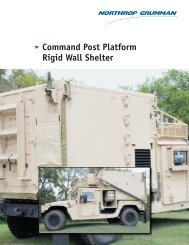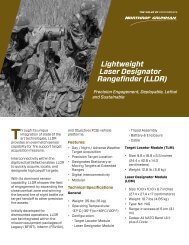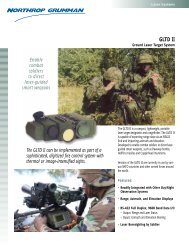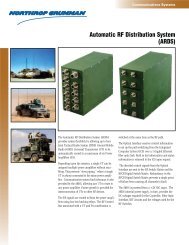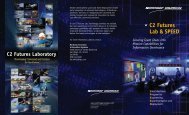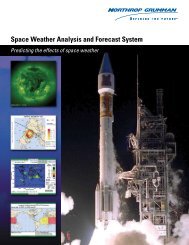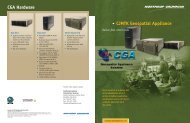VisionMaster FT Naval Radar and ECDIS - Northrop Grumman ...
VisionMaster FT Naval Radar and ECDIS - Northrop Grumman ...
VisionMaster FT Naval Radar and ECDIS - Northrop Grumman ...
You also want an ePaper? Increase the reach of your titles
YUMPU automatically turns print PDFs into web optimized ePapers that Google loves.
<strong>VisionMaster</strong> <strong>FT</strong>Series of <strong>Naval</strong> <strong>Radar</strong>s
<strong>VisionMaster</strong> <strong>FT</strong> MarineNavigation <strong>Radar</strong>sThe <strong>VisionMaster</strong> <strong>FT</strong> seriesof radars has been developedusing the latest technology,while building on the successof the BridgeMaster E series.Its unparalleled choice ofconfigurations <strong>and</strong> options givesit the flexibility needed for anytype, size <strong>and</strong> class of vessel. Itsversatility extends to high-speed<strong>and</strong> static site applications. Sinceits introduction, <strong>VisionMaster</strong> <strong>FT</strong>has seen great success. It hasbeen chosen as the preferredsystem of choice by major navies<strong>and</strong> coast guards around theworld.Specially Developed for theMilitary <strong>and</strong> ParamilitaryMarketsRecognizing the needs of military<strong>and</strong> paramilitary customers,the <strong>VisionMaster</strong> <strong>FT</strong> series of<strong>Naval</strong> <strong>Radar</strong>s has been speciallydeveloped to provide advancednavigational support for thetoughest military assignments.By combining the navigationalfeatures <strong>and</strong> functionsfound in the <strong>VisionMaster</strong> <strong>FT</strong>st<strong>and</strong>ard ARPA with enhancedfeatures <strong>and</strong> high performanceconfiguration, <strong>VisionMaster</strong> <strong>FT</strong><strong>Naval</strong> <strong>Radar</strong>s offer exceptionalmilitary capabilities without thehigh cost associated with most<strong>Naval</strong> <strong>Radar</strong>s.Main FeaturesRange in YardsIn addition to the st<strong>and</strong>ard radardistance units, the <strong>VisionMaster</strong><strong>FT</strong> <strong>Naval</strong>ized <strong>Radar</strong> display alsooffers the operator the choice ofdisplaying ranges in yards. This isselected during commissioning.Red First StrikeRed First Strike provides animmediate indication of fastmoving targets, such as fixed<strong>and</strong> rotary wing aircraft <strong>and</strong> fastattack craft, by highlighting themin red. This feature improvesthe operator’s reaction time bysimplifying the identification ofany potential threat.Target InterceptThe Target Intercept featureallows the operator to plan <strong>and</strong>execute intercept maneuversbetween one vessel <strong>and</strong> another.These interceptions can be to<strong>and</strong> from ownship, or from onetracked target or AIS target toanother. The course to achievethe interception is calculated<strong>and</strong> displayed on the screen.Graphical intercept vectors areRed First StrikeTarget Interceptdisplayed in the video circle toindicate where the interceptionwill take place.Helicopter ApproachThe ability to display a helicopterapproach sector on screen isof great value in assisting withhelicopter operations, especiallyin poor visibility. At a glance, theradar operator is able to checkthe status of the helicopter’sapproach <strong>and</strong> provide guidanceto the pilot.The approach sector may be setup on ownship or on any trackedtarget or AIS target.Queen Elizabeth Class (QEC) Aircraft Carrier. Photo courtesy of AircraftCarrier AllianceFreeze FrameIn any naval operation there maybe times when it is necessaryto impose radar silence. Duringthese times the operator can beprovided with a frozen picture ofthe radar situation immediatelybefore the radar silence wasimposed by using the ‘FreezeFrame’ function. The operatorcan freeze the picture locally orthe display can be integratedwith the vessel’s radar silencecapability.
Station KeepingIn bad weather conditions <strong>and</strong>at night, it is often difficultto maintain station on othersurrounding vessels. By usingthe station keeping feature, theoperator is able to set up a sectorfor each vessel nearby whichwill allow him to see at a glanceif any vessel has moved out ofits correct position. Targets canalso be assigned for automaticmonitoring with respect to thedefined station. The distance offstation is displayed <strong>and</strong> an alarmwill be raised if the target exitsthe station. Multiple targets canbe monitored simultaneously.Advanced Index LinesAdvanced index lines are usedby the military for blind pilotageoperations. Sperry Marine’s<strong>Naval</strong>ized display allows up to15 index lines to be displayedsimultaneously in groups offive. In order to minimize thecluttering effect of these lines,the operator is able to ‘clip’the lines to the exact lengthrequired. Multiple sets of linescan be prepared in advance <strong>and</strong>saved internally in individualfiles for later use. Index linesare automatically synchronizedbetween other <strong>VisionMaster</strong> <strong>FT</strong>systems on the same network,ensuring that all systems havethe most up-to-date dataavailable. Lines can also be savedto a USB memory device as aback-up or for transfer to othervessels.Advanced Index LinesLow Scanner Rotation SpeedsThe <strong>VisionMaster</strong> <strong>FT</strong> <strong>Naval</strong>ized<strong>Radar</strong> display has beendeveloped to support integrationwith scanner systems operatingat low rotating speed rates, downto 5rpm.Target RepairTarget repair allows the operatorto reposition the tracked targetsynthetics when they becomeseparated from the target video.This is done by moving thetracked target origin to its newposition while maintaining thefollowing target data:• Target ID number• Target Name• Existing past position dots• VelocityDrop LineThe Drop Line can be used tomanage targets of interest<strong>and</strong> reduce screen clutter <strong>and</strong>unwanted target alarms. Theline is drawn perpendicularto the ship’s course at anoperator adjustable distanceastern of ownship. Trackedtargets crossing the line <strong>and</strong>moving away from ownship areautomatically dropped unlessbeing used for echo reference.Optional Features• 600 Knot Tracking• CCTV Interface• Velocity AsynchronousSecondary <strong>Radar</strong> Input<strong>Naval</strong> TransceiverUsing enhancements intechnology, the <strong>VisionMaster</strong><strong>FT</strong> X-(I)-b<strong>and</strong> naval transceiverhas been developed to act asa centralized distribution unitfor radar synchronization. Itaccepts an external trigger input(200Hz-10KHz) that will allow itstransmission to be synchronizedwith other systems <strong>and</strong> threeindependent adjustablepretrigger signals outputs, whichmay be used by ownship’s EWsystems to avoid damage when aradar pulse is being transmitted.In addition, the <strong>VisionMaster</strong><strong>FT</strong> naval transceiver has twopositive <strong>and</strong> two negative radarvideo outputs, so that the videois available for other systemswithout the need for additionalsignal inversion circuitry. Inthe same way there are twosets of bearing data output inserial format (heading marker<strong>and</strong> incremental azimuthinformation).The availability of a wide rangeof inputs <strong>and</strong> outputs allows the<strong>VisionMaster</strong> <strong>FT</strong> radars tointerface quickly <strong>and</strong> easily withother onboard systems withoutusing multiple interfacing unitsthus reducing the complexityof the system <strong>and</strong> associatedcosts.
System ConfigurationsClient ServerSt<strong>and</strong>ardFor more information,please contact:SALESTel: +44 2083 292000sales@sperry.ngc.com24-HOUR SERVICETel: +31 10 44 51 630Fax: +31 10 44 51 632service.eu@sperry.ngc.comwww.northropgrumman.comSpecifications <strong>and</strong> features subject to change without notice.© 2013 <strong>Northrop</strong> <strong>Grumman</strong> Systems CorporationAll rights reserved.BR-221-BLB-0813A330: 13-1748N&MSD Comms


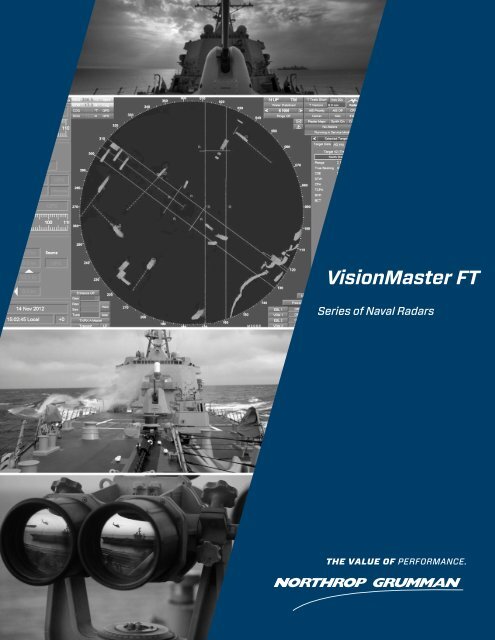
![[x] amendment of solicitation/modification of contract - Northrop ...](https://img.yumpu.com/51622731/1/190x245/x-amendment-of-solicitation-modification-of-contract-northrop-.jpg?quality=85)
